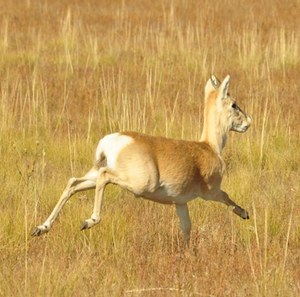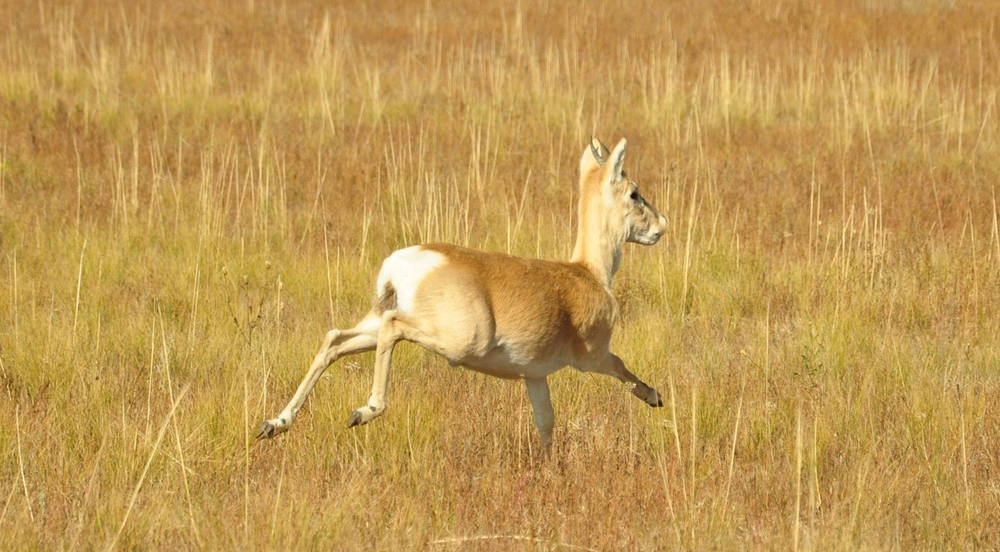Animal Communication Could Support Efficient Foraging
Animals communicate in many ways for many purposes. In Physical Review Letters, a team of physicists and ecologists presents a simple model demonstrating how a herd of animals might use vocalizations to help each other find food. Applying their model to data on Mongolian gazelles roaming the Asian steppe, the researchers find that the typical distance over which the gazelles communicate is roughly what’s needed for an efficient search strategy that allows all herd members to reach grazing areas.
A team of physicists and ecologists led by Ricardo Martínez-García of the Institute for Cross-Disciplinary Physics and Complex Systems in Palma de Mallorca, Spain, says that researchers have previously studied how communication among animals is used to establish and maintain groups. (“Where are you?” ”I’m over here!”) But there has been little research on how and whether communication aids specific activities that might benefit members of the group, such as finding food.
The team modeled a herd of animals as “particles” moving in a two-dimensional space. The equation of motion for the animals had three terms. One term related to the richness of vegetation across the landscape and caused each animal to move in the direction of better grazing. The second was a communication term, causing each animal to move in a prescribed way depending on what sounds it heard from other animals. Finally, there was a “white noise” term that mixed in an element of random or Brownian motion.
Constructing the communication term required further assumptions. The researchers proposed that an animal would emit a continuous signal only when it encountered vegetation with richness exceeding some critical value. These signals diminished with distance not only through the standard inverse-square dropoff in intensity, but also due to the effects of air temperature and humidity, which vary with sound frequency. In reaction to these calls, a given animal would move in the direction of the greatest average sound, which the team calculated as the vector sum of the sounds from other animals, accounting for both loudness and direction of each.
The researchers applied their model to the Mongolian gazelle (Procapra gutturosa), which roams the Eastern Steppe of Mongolia. From satellite imagery the researchers generated a map of vegetation richness across this area. They used tracking studies showing that the gazelles typically move about kilometers per day to calibrate the magnitude of the white noise element in the model. The range over which Mongolian gazelles can communicate is not directly known, but given the usual climate conditions in the open steppe landscape, the researchers could relate range to the frequency of vocalizations: lower pitched sounds travel farther.
To run a simulation, the team placed gazelles in an area about kilometers by kilometers and let them roam for a month. When the communication frequency was high ( kilohertz), significant numbers of animals were still wandering in vegetation-poor areas at the end of the simulation because they hadn’t been within earshot of other animals signaling the presence of food. But low frequency ( kilohertz) sounds, with longer range signals, produced a cacophony with little directional information, so animals also had trouble finding food. The best results—with all animals finding rich vegetation in a reasonable time—came about for a communication frequency of just over kilohertz, comfortably within the range of sounds the gazelles are known to produce, and corresponding to a plausible communication distance of a few kilometers. In this optimum case, the mean time for animals to find new food was about hours—an acceptable figure, the researchers say, given what is known of gazelle behavior in the wild.
Although the result that both an excess and a lack of information worsens search efficiency is not surprising, devising “a concrete, tractable model that is biologically realistic [and] sufficiently detailed” to make quantitative predictions is rare and noteworthy, says Andy Reynolds of Rothamsted Research in Harpenden, UK. Intuition is not always a reliable guide when it comes to animal behavior, he adds.
–David Lindley
David Lindley is a freelance science writer in Alexandria, Virginia.





